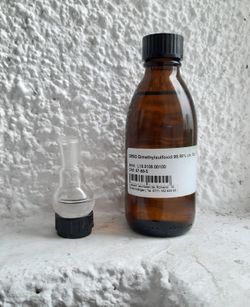Dimethyl sulfoxide
 Dimethyl sulfoxide sample
| |
| Names | |
|---|---|
| IUPAC name
Dimethyl sulfoxide
| |
| Other names
Dimethyl(oxido)sulfur
DMSO Methanesulfinylmethane Methyl sulfoxide Methylsulfinylmethane | |
| Properties | |
| (CH3)2SO | |
| Molar mass | 78.13 g/mol |
| Appearance | Colorless liquid |
| Odor | Odorless (pure) Foul (technical-grade) |
| Density | 1.1004 g/cm3 (20 °C) 1.0956 g/cm3 (25 °C) 1.0908 g/cm3 (30 °C) 1.0861 g/cm3 (35 °C) 1.0806 g/cm3 (40 °C) 1.0753 g/cm3 (45 °C) 1.0704 g/cm3 (50 °C) 1.0604 g/cm3 (60 °C) |
| Melting point | 19 °C (66 °F; 292 K) |
| Boiling point | 189 °C (372 °F; 462 K) |
| Miscible | |
| Solubility | Miscible with alcohols, carboxylic acids, esters Soluble in diethyl ether Immiscible with alkanes |
| Vapor pressure | 0.42 mmHg at 20 °C |
| Acidity (pKa) | 35 |
| Thermochemistry | |
| Hazards | |
| Safety data sheet | Sigma-Aldrich |
| Flash point | 89 °C (192 °F; 362 K) |
| Related compounds | |
| Related compounds
|
Acetone Methylsulfonylmethane |
| Except where otherwise noted, data are given for materials in their standard state (at 25 °C [77 °F], 100 kPa). | |
| Infobox references | |
Dimethyl sulfoxide (or DMSO) is an organosulfur compound with the formula (CH3)2SO. This colorless liquid is an important polar aprotic solvent that dissolves both polar and nonpolar compounds and is miscible in a wide range of organic solvents as well as water.
Contents
Properties
Chemical
DMSO will oxidize a primary halide to form an aldehyde, process known as Kornblum oxidation.
Gentle oxidation of DMSO gives dimethyl sulfone (methylsulfonylmethane).
DMSO does not react with many aggressive compounds, such as sodium hydroxide or sodium cyanide, even under a 24 hour reflux. Strong acids, like conc. sulfuric acid and hydrochloric acids do not cause appreciable degradation, even at 100 °C, however, phosphoric acid will decompose DMSO at the same temperature much faster than the latter two acids.[1]
DMSO will form trimethylsulfoxonium iodide with methyl iodide:
- (CH3)2SO + CH3I → [(CH3)3SO]I
Physical
DMSO is a clear, colorless, odorless liquid at standard conditions. It is miscible with a variety of liquids, such as water, alcohol, diethyl ether. As a polar aprotic solvent, DMSO can dissolve a surprising variety of organic and inorganic compounds.[2] However, due to it's high freezing point, DMSO is not suitable for recrystallizations.
Availability
DMSO is available at chemical suppliers. It is also commonly available at pet stores for cleaning dogs ears. In some countries, such as the Russian Federation, DMSO is sold in drugstores (it is useful for making poultices).
Preparation
DMSO can be prepared by oxidizing dimethyl sulfide with an oxidizer, like oxygen, hydrogen peroxide or nitrogen dioxide. Dimethyl sulfide can be prepared via various routes, one simple route involves stirring a solution of methyl iodide in methanol, and an aqueous solution of sodium sulfide is added. The reaction is sufficiently exothermic that no heating is required. The crude dimethyl sulfide is purified via fractional distillation. Since the product is very volatile, the yield of this process is usually around 50%.[3]
The procedure is not easy to do, as concentrated dimethyl sulfide is very toxic and has an absolutely unbearable odor. The crude DMSO obtained will be heavily contaminated with dimethyl sulfide and DMSO2, and you will have to purify it via vacuum distillation. Atmospheric distillation of DMSO is not possible, as the compound will decomposes before its boiling point, sometimes very violently.
DO NOT WORK WITH ORGANIC SULFIDES IN POPULATED AREAS!
Projects
- Organic extractions
- Chemoluminescence of the Luminol-NaOH-DMSO System
Handling
Safety
DMSO penetrates the skin very readily and has the unusual property that many individuals perceive a garlic-like taste in the mouth after contact of DMSO with the skin. DMSO isn't very toxic, but it can act as a pathway to allow any toxic substances dissolved in it straight into the blood stream.
Because DMSO easily penetrates the skin, substances dissolved in DMSO may be quickly absorbed. Glove selection is important when working with DMSO. Butyl rubber, fluoroelastomer, neoprene, or thick (15 mil) latex gloves are recommended. Nitrile gloves, which are very commonly used in chemical laboratories, may protect from brief contact but have been found to degrade rapidly with exposure to DMSO.
Storage
DMSO should be stored in closed bottles, to prevent outside contamination. As it has a high boiling point, very little solvent evaporates over time. However, due to it's high melting point (19°C), DMSO will freeze if kept in a cold place. DMSO will slowly absorb water from air, so if you want to keep it dry, it's best to keep it in sealed containers/bottles, with fresh molecular sieves.
Disposal
DMSO wastes should be mixed with another organic solvent and burned in an incinerator equipped with an afterburner and a scrubber.
References
- ↑ http://chemistry-chemists.com/N3_2011/U/DMSO-technical_bulletin.pdf
- ↑ http://www.gaylordchemical.com/uploads/images/pdfs/literature/102B_english.pdf
- ↑ Tarbell, Weaver; Journal of the American Chemical Society; vol. 63; (1941); p. 2939,2942